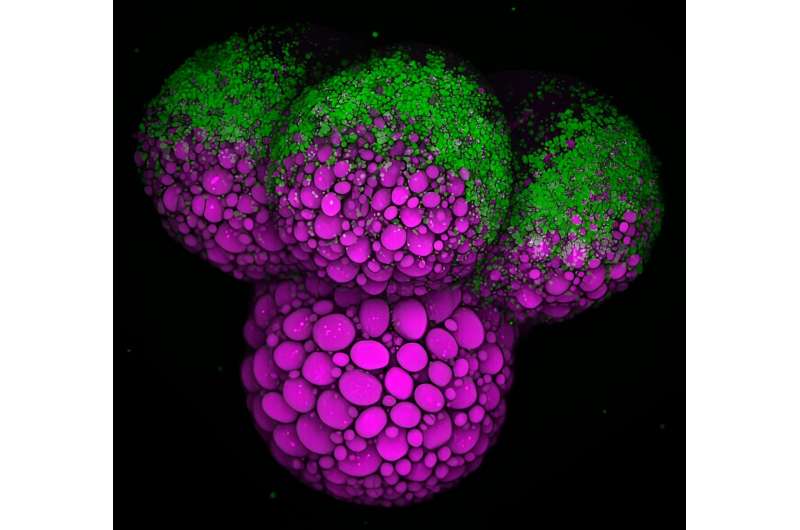This article has been reviewed according to Science X's editorial process and policies. Editors have highlighted the following attributes while ensuring the content's credibility:
fact-checked
peer-reviewed publication
trusted source
proofread
New research on fruit flies provides key insights into the nutrients essential for embryo development

It is well known in development biology that a mother's egg provides abundant nutrients that are essential for an embryo to develop. But does it matter where in the developing embryo the nutrients are stored?
In a series of papers, Michael Welte, a professor in the University of Rochester's Department of Biology, tackles this question, which falls at the intersection of developmental biology and metabolism. The studies were spearheaded by Marcus Kilwein, a former graduate student in Welte's lab, who is now a postdoctoral fellow at Princeton University.
The segregation of protein, fat, and carbohydrates
In the first paper, published in the journal Development, Welte and Kilwein studied three main categories of nutrients in Drosophila (fruit fly) eggs: protein, fat, and carbohydrates. These three nutrients are present in thousands of microscopic storage units, with each nutrient type packaged separately from the others. Immediately after fertilization, the three types of nutrient packages are distributed throughout the egg. However, within four hours after fertilization, fat and protein are segregated into different types of cells, while the fate of carbohydrates was previously unknown.
The researchers found that carbohydrates also get segregated from the fat, into the same cells that receive protein. This segregation requires that fat and carbohydrates move independently from each other.
Kilwein and Welte discovered that a protein present on lipid droplets—storage units for energy in the form of lipids or fats—is necessary to keep fat and carbohydrates apart. When this protein is missing, fat and carbohydrate packages bind to each, fail to segregate, and end up together with the protein in the same cell. The result is an embryo that struggles to use fat effectively, with dire consequences for the embryo's development.
Separation of fat: A crucial component of embryo development
In a second paper, published in the journal PLoS Genetics, Welte explored why it is crucial that fat is segregated from carbohydrates and proteins.
"We suspected [the segregation of fat] was essential because Drosophila embryos use multiple elaborate mechanisms to ensure that the fat gets to the right place, including the mechanism we discovered in the first paper," Welte says. "Because this segregation likely requires lots of energy to accomplish, we thought it must play an important function for the embryo, but we did not know what it might be."
He found evidence that the segregation of fat is not unique to flies but also occurs in other organisms such as snails, sponges, and mice. This suggests it might be a universal phenomenon in organisms and therefore also occurring in human embryos.
To better understand the importance of nutrient segregation, Welte and his team disrupted the segregation process in fruit flies and observed the consequences. The research showed that when fat ends up in the wrong cells, it leads to significant changes in metabolism and stressed embryos.
To cope with this stress, the embryos mount a protective response by changing their gene expression; without this response, they die, and even with it, their development is significantly delayed.
Overall, the findings indicate that it is not only essential for a developing embryo to receive sufficient fat from the mother's egg; it is also crucial for the fat to be distributed to the right cells during development.
"The embryo shuttles the fat to the tissues that need it most," Welte says. "The mechanism we discovered allows the mother to endow the embryo with fewer fat supplies overall than if the fat were evenly distributed, while still supporting successful embryo development. As a result, the mother can presumably lay more eggs because she can distribute the same amount of nutrients between more eggs, ensuring higher numbers of offspring."
More information: Marcus D. Kilwein et al, Drosophilaembryos spatially sort their nutrient stores to facilitate their utilization, Development (2023). DOI: 10.1242/dev.201423
Marcus D. Kilwein et al, Drosophila embryos allocate lipid droplets to specific lineages to ensure punctual development and redox homeostasis, PLOS Genetics (2023). DOI: 10.1371/journal.pgen.1010875
Journal information: Development , PLoS Genetics
Provided by University of Rochester



















